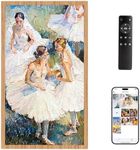Buying Guide for the Best Digital Photo Frames
Digital photo frames are a great way to display your favorite photos without the need for printing. They can be a wonderful addition to your home or office, allowing you to showcase a rotating selection of images. When choosing a digital photo frame, it's important to consider several key specifications to ensure you get the best fit for your needs. Here are the main specs to look out for and how to navigate them.Screen SizeScreen size refers to the diagonal measurement of the display area. This is important because it determines how large your photos will appear. Smaller frames, around 7-8 inches, are great for desks or small spaces. Medium frames, around 10-12 inches, are versatile and can fit well in most settings. Larger frames, 15 inches and above, are ideal for living rooms or areas where you want a more prominent display. Choose a size that fits the space where you plan to place the frame and how visible you want the photos to be.
ResolutionResolution is the number of pixels that make up the display, typically measured in width x height (e.g., 1024x768). Higher resolution means sharper and clearer images. For smaller frames, a resolution of 800x600 may be sufficient. For medium to large frames, look for at least 1024x768 or higher. If you want the best image quality, especially for larger frames, consider resolutions of 1920x1080 or higher. Your choice should depend on how much detail you want in your photos and how close you will be viewing the frame.
Storage CapacityStorage capacity determines how many photos you can store on the frame. Some frames come with built-in storage, while others rely on external memory cards or USB drives. Built-in storage can range from a few megabytes to several gigabytes. If you have a large photo collection or want to display high-resolution images, look for frames with larger storage capacities or those that support expandable storage options. Consider how many photos you want to display and whether you prefer the convenience of built-in storage or the flexibility of external storage.
ConnectivityConnectivity options include Wi-Fi, Bluetooth, USB ports, and memory card slots. Wi-Fi-enabled frames can connect to your home network, allowing you to upload photos directly from your smartphone or computer. Bluetooth can be useful for quick transfers from mobile devices. USB ports and memory card slots provide a way to load photos directly from external storage devices. Choose a frame with the connectivity options that best match your preferred method of transferring photos. If you want to update your photos frequently and easily, Wi-Fi connectivity is a great feature to have.
Aspect RatioAspect ratio is the ratio of the width to the height of the display. Common aspect ratios for digital photo frames are 4:3 and 16:9. A 4:3 aspect ratio is closer to the shape of most digital camera photos, which means your images will fill the screen without black bars. A 16:9 aspect ratio is more suited for widescreen images and videos. Choose an aspect ratio that matches the format of your photos to avoid cropping or distortion. If you have a mix of photo formats, look for frames that offer adjustable aspect ratios or automatic cropping features.
User Interface and FeaturesThe user interface and additional features can greatly affect your experience with a digital photo frame. Look for frames with intuitive controls, such as touchscreens or remote controls. Some frames offer slideshow options, transition effects, and the ability to play videos or music. Others may have calendar and clock functions. Consider what features are important to you and how easy the frame is to use. If you want a simple, hassle-free experience, choose a frame with a straightforward interface and the features you will actually use.
Power SourceDigital photo frames can be powered by batteries or an AC adapter. Battery-powered frames offer portability and can be placed anywhere without worrying about power outlets, but they may require frequent recharging or battery replacement. AC-powered frames need to be plugged into an outlet, which limits their placement but provides a constant power supply. Consider where you plan to use the frame and whether you need the flexibility of a battery-powered option or the reliability of an AC-powered frame.





















